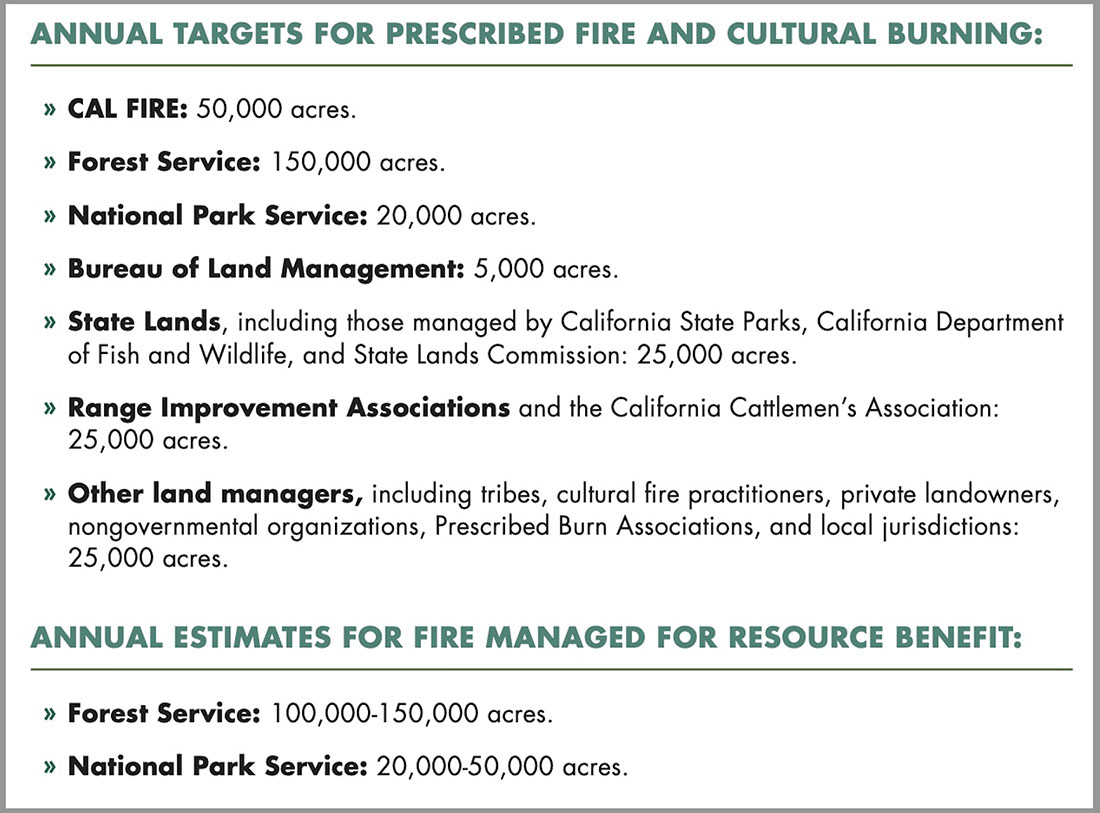Bill Gabbert takes a look at the California beneficial fire plan at Wildfire Today here.
It seems like the FS has most of the work, 150K acres annually target for PB and “estimated” for FMRB. Now, we would not like, perhaps, the FS to have a target for FMRB (or would we?) because that might affect their decision-making (or would it?). So what does it mean (if anything) to lay that number out there.. an FMRB program as big as the PF program?
I wonder whether the pre-fire decision making for FMRB uses the same thinking for the Park Service, the State on private lands, and the Forest Service, and exactly what kind of pre-fire decision-making is required? A Fire use plan amendment? Maybe all of that is in the Strategic Plan.
This is important to highlight, I think, because there are folks who are concerned over the use of FMRB in particular, and if half your program is that, it seems like it’s particularly important to develop trust and social license; open decision-making seems like one piece of that.
Anyway, here are some excerpts from Bill’s post:
The plan released last week by the Governor’s Wildfire and Forest Resilience Task Force indicates that the state of California will begin managing some fires for resource benefit, major change in their policy. They will evaluate areas on state land where modified fire suppression strategies can be implemented, such as land trusts, ranches, and timber owners. Where appropriate and authorized by the state Legislature, CAL FIRE will use plans and agreements with land managers and landowners in order to allow unintentional ignitions to burn under predetermined and prescribed conditions, to accomplish resource benefits similar to prescribed fire.
The key elements of the plan include:
- Launching an online prescribed fire permitting system to streamline the review and approval of prescribed fire projects;
- Establishing the state’s new Prescribed Fire Claims Fund to reduce liability for private burners;
- Beginning a statewide program to enable tribes and cultural fire practitioners to revitalize cultural burning practices;
- A prescribed fire training center to grow, train, and diversify the state’s prescribed fire workforce;
- An interagency beneficial fire tracking system;
- Pilot projects to undertake larger landscape-scale burns; and
- A comprehensive review of the state’s smoke management programs to facilitate prescribed fire while protecting public health.
“This plan is vital to improve the health and resilience of the state’s forests, reduce wildfire risk of vulnerable communities, and increase stewardship by Native American fire practitioners,” said Task Force Co-Chair and U.S. Forest Service Regional Forester Jennifer Eberlien.

The plan, California’s Strategic Plan for Expanding the use of Beneficial Fire, March 2022, was developed by the Governor’s Wildfire and Forest Resilience Task Force. It can be downloaded here: (large 17 MB file).
Especially after last year’s Tamarack Fire, the sentiment against FMRB is probably at an all-time high. Some people even see it as a political issue, and they will not be convinced otherwise (due to conspiracy theories on both extremes). With the Dixie Fire burning so much, we do have to consider these drought-impacted forests to be at risk to complete loss from wildfires. THAT is the new “No Action Alternative”, it seems, here in California.
From what I’ve seen, it seems like this concern is mostly in California, at least for now. Based on notes I’ve seen from a NACO meeting, it sounded like if you trust your local line officer in general, you might also trust the FMRB decisions they make.
Then there’s is also the question of fires where full suppression may not occur due to safety, or availability of resources, getting mixed in with intentional FMRB.
For sure it’s a challenge, and as with so many other issues, calls for a venue where both sides can listen to each other and derive a solution- instead of grandstanding and stiff-arming, and all possible combinations thereof.
The firefighting safety issue is something that the Forest Service has trouble in making the public understand. Many fires just cannot be safely fought in a direct manner. At least, here in California, there are some places where strategic fuelbreaks would have value (unlike other western States). Some areas just do not have wide ridgetops, suitable for permanent fuelbreaks.
I am against FMRB during the peak wildfire months. We need the resources ready and available, and not sitting on ‘preserved wildfires’, with dubious resource benefits.
Does FMRB (w/o Google) stand for “Fire Management for Resource Benefit?” Something like that? Is that the same as “free to burn?” I think I’ve discussed my dislike of government acronyms before. From my perspective, they are far more obfuscation than clarification — and that always makes me suspicious rather than informed.
Are these FMRB acreages included as “fuel treatment?” If they are burning green trees and thereby creating even greater fuel loads, is this being recognized and accounted for? These aren’t rhetorical questions — I have little idea what is being discussed or how that affects the numbers being released.
Bad idea. Calfire and the Forest Service already do this. Full suppression never means full suppression. It means they get to spend as much money as they want. I think we need to reduce the amount of acres burned. This is especially true when burning up our remaining old growth forests. (Or any forest for that matter. I like green living trees.)
Has nobody noticed the amount of forests that have burned in the last 20 years? We need to take a close look at beneficial fire and truly try and understand where it may be appropriate.
It seems to me it most beneficial at the edges of the forest.